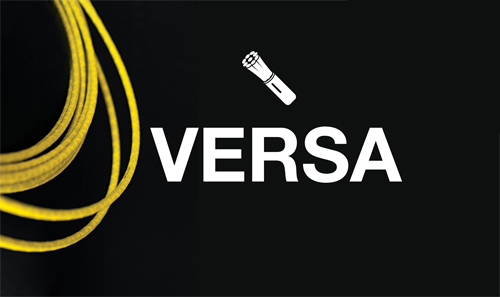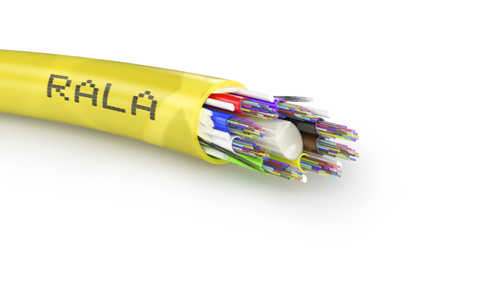
Rala supplies micro cabling of the highest quality and it is important to us that we provide the right characteristics.
Exceptional installation capacity not least in the form of unprecedented blow lengths ( replace blow lengths with blowing distances), mechanical protection over a long period of time and very simple preparation make Rala’s micro cables an excellent basis for future-proof fibre networks.
You can easily recognise a Rala cable – all of our fibre cables have yellow sleeving.
Introducing VERSA – our thinnest fibre cables ever! Versa 250 and 200. Versatile micro cables. From Rala.

Ever since Rala introduced micro cables, in the early 2000s, with the help of advanced technology we have led the trend toward higher capacity, better reliability, smaller dimensions and easier handling.
Now we are launching a new generation of micro cable – Versa – with improved performance right across the board. A series of robust fibre cables with performance and reliability that will last long into the future.
The Versa series is available in two models – Versa 250 and Versa 200. The series has been developed to suit all applications, and simplifies the entire process – from design to finished installation and maintenance.

The Versa series makes your choice of cable easy – it can be used between cities, in towns, in residential areas and even in rural areas. And it offers lots of advantages:
-Long life
-The market’s lowest attenuation values for microbendings
-Increased attenuation budget
-Simpler mid-span
-Temperature resistance from -40°C to +70°C
-Copes easily with harsh climatic conditions
Construction: 8 tubes x 24 fibres
Tube size: Ø 1.65 mm
Cable: Ø 7.0 mm
Cable weight: 47 kg/km
Drum size: K9
Download folders for VERSA – fibre cables:
–Micro cable Versa 250/288
–Micro cable Versa 250/24 och 48
–Micro cable Versa 250/96
–Micro cable Versa 200/192
–Micro cable Versa 250/144
–Micro cable Versa 250/192
Click here if you would like to know more about Versa.
Unitube combines a simple design with incredible installation characteristics. The fibres are located in strands in a single central tube. This makes it easy to work with while it can still handle typical Nordic requirement specifications. Ideal for use in micro-ducts, such as 25/10 or 16/12, where installation lengths are incredible.
The simplest way to go from point to point
Unitube cable is ingeniously simple and with all fibres located in a single tube it also saves space. All cables are small, mechanically strong and often perform best in blown installations.
They are intended for point-to-point installations, such as the supply of a splicing point or as a link between two nodes where a lot of fibre is required. In addition, they can be opened to pull out an individual strand and branch off it.
Unitube Mini
The latest version of Unitube cable: Unitube Mini. Only 2.5 mm in diameter, Unitube Mini can be installed in microtubes with an inner diameter of 3.5 mm. The cables now hold up to 12 fibres. Perfect for a multi-family property or a business.
Loose-tube consists of fibres in loose tubes around a strength member. With a dry core but also longitudinally watertight. Easy to reach every fibre, for example for branching. From 48 to 288 fibres – for microducts or regular 40/32 ducting!
Fibre in tubes for easy branching
The design, with loose tubes around a strength member, makes it easy to access the fibres in each tube. This is particularly advantageous where only a few fibres need to be divided and spliced. This sort of micro-cable – whether 48 or 216 fibres in the cable – has tubes placed in a single layer. This makes it even easier to get to the individual fibres. Where there are large numbers of fibres, the strands are separated with strand band. The strand band can be removed quickly and with a simple loop around each strand it can be easily identified, which simplifies the preparation of the cables.
So small. So many fibres
The range begins with 48 fibres, but it is at higher fibre counts that the benefits are clearest. So far we have managed to get 216 fibres into a cable that is only about 8.4 mm in diameter. And our new fibre cable has 96 fibres and measures 6.5 mm. In addition to the fact that its small diameter allows installation in 12/10 or 14/10 mm microducting, the drums are smaller, which facilitates logistics. Loops can also be smaller, which offers definite advantages whether in manholes, cabinets or ODFs.
Our new micro-cable for 288 fibres has a diameter of 10.2 mm which makes it suitable for installation in 25/19 tubing or larger.
Only 1.8 mm – yet fully grown. Small, smooth and strong. Can handle the Swedish climate through temperature specifications, water resistance and mechanical strength. With its small diameter, FTTx cable is easy to handle at each termination.
A small but fully-fledged cable
Cables have become smaller. This is a development that the micro-cable system JETnet® has driven and now systems are becoming increasingly easy to build, maintain and upgrade. Swedish conditions are tough and so there are high technical requirements for fibre to be protected and thus last for its intended service life. That is why we say that our FTTx cable is fully-fledged. It can cope with the correct temperature range, resist external pressure without more cushioning and handle tension. The cable thus lives up to all the requirements of the environment/climate.
Easily worked
Offering peak blowing performance, the cable can withstand handling and is easy to strip. This means that the cable offers an excellent basis for FTTx installations outdoors.
Ideal when combined with BendBright XS
More and more people are using BendBright XS. It is now the most commonly used fibre in Swedish installations of FTTx cable. The reason for this is that BendBright XS is robust, can withstand small bend radii and therefore allows for neat installations.
Flextube HD features a compact design that allows for an incredible amount of fibre in a cable with a small diameter.
Can be installed in ducting via either blowing or drawing and offers between 288 and 864 fibres distributed in flexible tubes. Properties combine temperature stability with flexibility and exceptional ease of preparation. The tubes can be stripped without tools and the small amount of gel required to give water tightness is easy to wash off. Almost like a completely dry installation. All the fibres are easy to access.
Your most important decision is your choice of fibre. Cables are designed to protect the fibre and ensure it meets environmental, handling and stress loads for a very long time. When choosing fibre, you are also choosing performance, quality and functionality. The latest evolution is glass fibre.
Low attenuation from 1285 to 1625 nm
All single mode fibres according to ITU-T Rec G.652D and ITU-T Rec G.657.xx have low attenuation from around 1285 up to just over 1625 nm. This means you can use not only the 1310, 1550 and 1625 nm wavelengths for transfer transmission, but also large parts of the wavelengths in between. For example, if wavelength multiplexing (DWDM/CWDM) is used, these fibres cope perfectly. This is already normal in the backhaul and backbone of fibre networks. Standardisation is also under way for use in access networks. With our single mode fibre, you’re prepared for the future.
Our fibre also has low PMD values; a particularly important feature for transport transmission over long distances.
ColorLock – bright colours that won’t fade away
Originally all fibre was transparent, then later it was painted with the required colour. Our fibre utilises a new technology where the colour is directly integrated into the outer coating of the fibre. The biggest advantages of this lie in the bright, clear colours which don’t fade and the better flexural properties of the fibre. This results in easier installation and documentation. At the same time, the fibres are more durable and last longer.
Rala provides micro-cable of the highest quality which offers all the right characteristics. Exceptional installation capacity not least in the form of unprecedented blow lengths, mechanical protection over a long period of time and very simple preparation make our micro cables an excellent basis for future-proof fibre networks.
A fibre cable needs to be small, able to withstand stress throughout a long lifetime and be easy to install. Today, micro cables can take on all roles in a fibre network. Our cables with their mechanical protection of fibre and their design, allow easy handling, acts as barrier against moisture and make ideal carriers of vital infrastructure. Whether that means services to banks, hospitals or homes. They are reliable enough to be part of the intensive, economically vital and mission-critical backbone of any public fibre network.
Tidiness and simplicity
Technical performance always comes first. But for those who want to save time and money, it is also important that cables are easy to identify. Partly because that will make them quicker and easier to splice. Partly because simple wiring is easier to enter into the documentation system. Therefore, our colour-coding is always the same, no matter which product you use. From autumn 2012, we have adapted a new common colour-coding system, S12, for Sweden. With the introduction of this new system, we began to phase out cables that had the older colour-coding system. More information can be found in our product sheets and if you have any further questions, please feel free to contact us.
Custom lengths for a better project
All cables are normally delivered in standard lengths. They can, however, be cut into custom lengths. This saves money by pre-splicing and means less waste in the field.
Fibres and fibre cable can be easily recycled.
Neither fibres nor cable contain substances, during normal handling, that will cause harm to the environment or personnel.
Sorting and recycling
Fibres and fibre cable are treated as combustible waste. Be careful with individual loose fibres and ensure that they are properly handled in all situations.